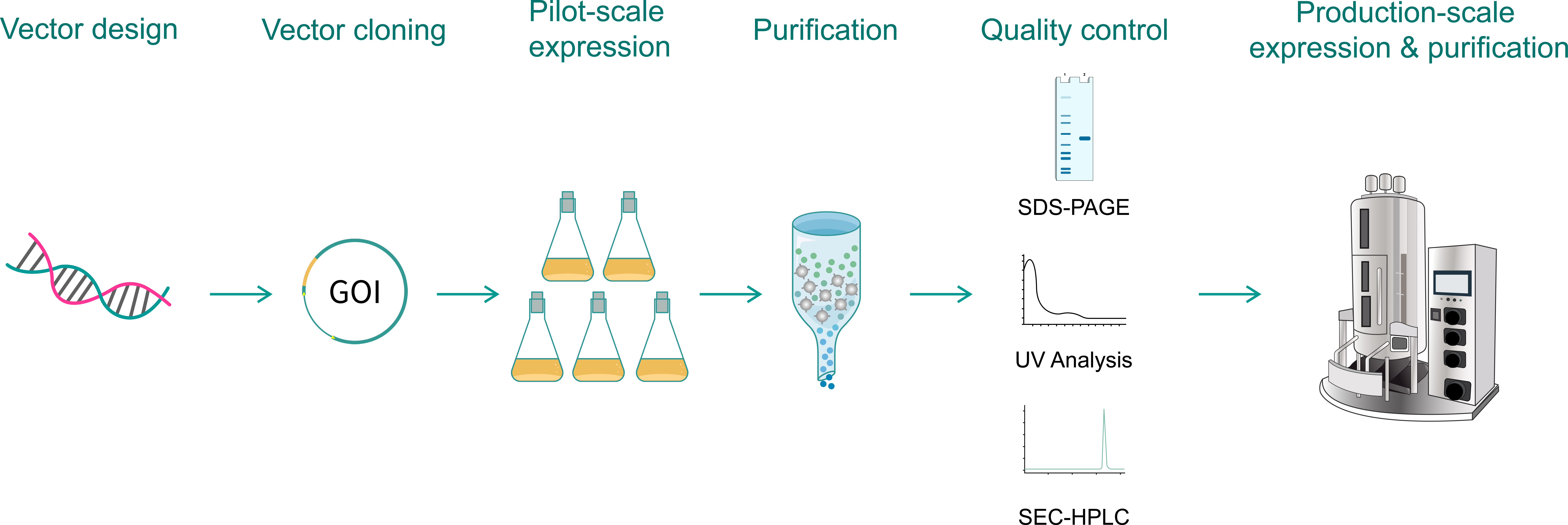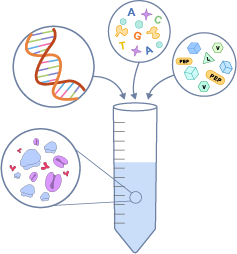VectorBuilder는 여러 발현 플랫폼을 사용하여 단백질 구조 분석, 효소 분석 개발, 신약 개발, 진단 및 바이오엔지니어링과 같은 다양한 응용 분야에 적합한 맞춤형 재조합 단백질 생산 서비스를 제공합니다. VectorBuilder의 단백질 생산 공정은 맞춤형 재조합 단백질 발현 벡터를 활용하여 고품질 재조합 단백질을 생성하는데 최적화되어 있습니다. 또한 고객이 제공한 벡터로부터 재조합 단백질을 생산할 수도 있습니다.
중점 사항
- 원스톱 솔루션: 벡터 디자인부터 생산 규모의 단백질 정제까지
- 포괄적인 플랫폼: 다양한 발현 시스템 중에서 선택할 수 있는 유연성
- 고객 맞춤형: 매우 직관적인 벡터 디자인 플랫폼에서 다양한 정제 또는 검출 태그를 자유롭게 추가
- 고성능: 고품질을 보장하기 위해 광범위한 정제 방법과 QC 서비스를 사용 가능
재조합 단백질 발현 시스템
FAQ
어떤 재조합 단백질 발현 시스템을 선택해야 합니까?
프로젝트에 가장 적합한 시스템을 선택할 때 모든 재조합 단백질 발현 시스템은 고려해야할 장단점이 있습니다. 아래 표에는 각 시스템의 장단점이 요약되어 있습니다.
| Recombinant protein expression system |
Pros |
Cons |
| Bacteria |
- Cost-effective
- Short production time
- Technically simple
- Can be scaled up easily
- High protein yield
|
- Proteins lack post-translational modifications
- Codon usage is different from that of eukaryotes
- Difficult to express certain proteins due to the accumulation of inclusion bodies
- Some proteins are toxic and can inhibit bacterial growth
|
| Mammalian cells |
- Produces proteins in their most natural state with all necessary post-translational modifications and proper folding
- Suitable for secretory and membrane proteins
- Most appropriate for producing therapeutic proteins
|
- Long production time
- Requires complex growth conditions
- Scaling up can be difficult
- Not suitable for intracellular proteins due to low yield
|
| Insect |
- Performs majority of complex post-translational modifications and protein folding
- Suitable for secretory, intracellular, and membrane proteins
- Can be used for producing large protein complexes
- High levels of protein expression compared to other eukaryotic expression systems
- Highly scalable due to high-density, suspension cell cultures
|
- Long production time
- Requires complex growth conditions
- Technically challenging
|
| Cell-free system |
- Time-efficient synthesis completed in 3 hours
- No need for live cells in the production of toxic, complex, or unstable proteins
- Suitable for high-throughput protein expression and screening
- Easy procedure compatible with automated processes
- Easy to optimize the conditions
|
- Limited modifications are available
|
어떤 단백질 태그를 사용해야 하나요?
태그는 재조합 단백질 생산에 자주 활용됩니다. 태그는 정제 과정을 간소화하고, 특정 태그에서는 단백질 용해도, 수율 또는 순도가 향상되는 것으로 나타났습니다. Protease 절단 부위에 태그가 부착되어 있으면 정제 후 제거가 가능하며, 목적 단백질에 따라 절단 효율이 달라집니다. 적절한 태그를 신중하게 선택하는 것은 다운스트림 단백질 발현 및 정제에 매우 중요합니다. 아래 표에는 일반적으로 사용되는 태그의 개요와 장점 및 제한사항이 정리되었습니다.
| Tag |
Commonly applied system |
Advantages |
Limitations |
| GST |
Bacteria, insect |
- Largely preserves the native structure of the protein
- Enables protein purification under mild conditions
- Easy cleavage
- Enhances the solubility and expression of the protein
|
- Large tag size
- Dimerization may impact the target protein
- Not suitable for purifying proteins under denaturing conditions
|
| His |
All |
- Small tag size, therefore less impact on the protein
- Low cost for metal-affinity chromatography
- Low immunogenicity
- Suitable for purifying proteins under denaturing conditions
|
- Other endogenous metal-binding proteins in microbial hosts may be co-purified, therefore optimization is usually required
- Does not facilitate protein folding and solubility
|
| SUMO |
Bacteria, insect |
- Facilitates protein folding
- Enhances the solubility and expression of the protein
|
- May undergo non-specific cleavage by other bacterial proteins
- Not suitable for purifying proteins under denaturing conditions
|
| Flag |
Mammalian cells, insect |
- Small tag size, therefore less impact on the protein
- Easy detection
- Low non-specific binding
|
- Poor efficacy for purification
|
| MBP |
Bacteria, insect |
- Enhances the solubility and expression of the protein
|
- Large tag size
- Not suitable for purifying proteins under denaturing conditions
|
| Fc |
Mammalian cells, insect |
- Enhances the solubility and expression of proteins
- Suitable for secreted protein
|
|
For more information regarding tags, please visit protein tags.
VectorBuilder는 어떤 QC 서비스를 제공합니까?
VectorBuilder에서 클로닝된 모든 벡터는 100% 서열을 보증합니다. VectorBuilder가 생산하는 모든 재조합 단백질은 엄격한 품질관리를 받습니다. 대부분의 시스템에 대한 기본 QC에는 1) 제한효소 절단 분석 및 Sanger 시퀀싱을 통한 단백질 발현 벡터의 검증, 및 2) A260/280 측정 및 SDS-PAGE에 의한 단백질 농도 및 순도 측정이 포함됩니다. 일반적인 추가 QC 서비스는 아래 표에 나와 있으며 별도 요청시 제공될 수 있습니다.
| Additional QC services |
Method |
| Endotoxin test |
LAL |
| Protein characterization |
Western Blot |
| Intact MS (reduced) |
| SEC-HPLC |
| SEC-MALs |
| Protein N-terminal sequencing |
| Host cell protein test |
| Tag removal |
Protease digestion |
| Kinetics and affinity analysis |
Octet |
| Biacore |
| Pathogen testing panel for rodents |
Please inquire about other QC services.
사용 가능한 정제 방법은 무엇입니까?
VectorBuilder는 size exclusion chromatography (gel filtration), affinity purification, ion exchange chromatography, 및 hydrophobic chromatography를 포함한 광범위한 단백질 정제 방법을 제공합니다. His 태그 또는 GST 태그가 붙은 재조합 단백질의 경우 affinity chromatography가 일반적으로 포함되는 반면, 태그가 없는 재조합 단백질의 경우 size exclusion chromatography (gel filtration)가 일반적으로 포함됩니다. 정제 방법의 선택은 컨스트럭트 디자인 및 단백질 특성에 따라 결정됩니다.








